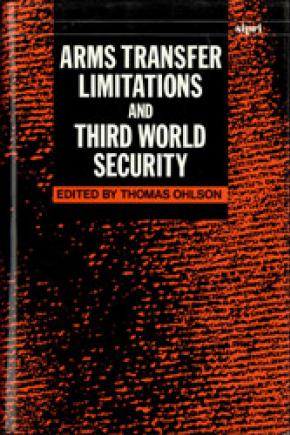Arms Transfer Limitations and Third World Security
Is the arms trade totally uncontrolled? What are the main obstacles to limitations on arms transfers? What can be learned from past attempts at arms transfer controls? This book assesses past efforts, current proposals and future possibilities to limit the transfer of weapons and military technology to Third World countries.
The arms trade is now a focus of international concern, as well as a key issue in the domestic politics of many arms supplier and recipient states. Not only are the implications of arms transfers vital to matters of security and the prudent use of limited resources, but the current arms market also generates clashes between short-term commercial and political gains and longer-term foreign policy goals. The most striking example of these forces at work is the case of arms transfers to Iraq and Iran during the 1980s.
Arms transfer limitation measures are extremely difficult to undertake, partly because national interests—instead of regional or global concerns—steer the willingness to restrain or not to restrain the arms trade. The contributors to this study conclude that attempts at multilateral arms transfer limitations are more likely to be successful if initiated by recipient rather than supplier countries, and they argue convincingly that, in order to pave the way for effective limitation measures, there is an urgent need for confidence-building measures that will modify attitudes towards such concepts as security.
Arms Transfer Limitations and Third World Security completes SIPRI's trilogy on the facts and implications of Third World buildups of major conventional weapons. It is a companion to the two SIPRI volumes Arms Production in the Third World (1986) and Arms Transfers to the Third World, 1971–85 (OUP, 1987).
Introduction
Thomas Ohlson
Part I. Controversies
1. Third World arms control and world system conflicts
Björn Hettne
2. Third World arms control in a hegemonistic world
K. Subrahmanyam
3. Third World arms control: A Third World responsibility
Nicole Ball
4. Third World arms control, military technology and alternative security
Chris Smith
Part II. Supplier control
5. US policy on arms transfer to the Third World
Michael T. Klare
6. Soviet arms transfer restraint
Joachim Krause
7. The Conventional Arms Transfers Talks: An experiment in mutual arms trade restraint
Jo L. Husbands and Anne Hessing Cahn
8. Problems and prospects of arms transfer limitations among second-tier suppliers: The cases of France, the United Kingdom and the Federal Republic of Germany
Frederic S. Pearson
9. Arms transfer limitations: The case of Sweden
Björn Hagelin
Part III. Recipient control
10. Regional arms control in the South American context
Augusto Varas
11. Problems and prospects for arms control in South-East Asia
Muthiah Alagappa and Noordin Sopiee
12. Third World arms control: Role of the non-aligned movement
S. D. Muni
Part IV. Integrating approaches
13. Arms transfer control and proposals to link disarmament to development
Jacques Fontanel and Jean-François Guilhaudis
14. The nuclear non-proliferation regime as a model for conventional armament restraint
John Simpson
Assessment
Thomas Ohlson

